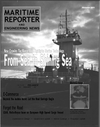
MAN B&W Touts Proven Tech in New 48/60B Engine
With the new version of its 48/60B medium-speed engine series, MAN B&W Diesel is attempting to prove that a cautious but successful modernization of proven technology is possible. The development of this new engine is based on the 48/60 series, of which 255 engines have been sold. The engine manufacturer, in announcing the new engine, not those nearly all-important features have been upgraded, while its hallmark sturdiness remains.
Since their launch in 1989, the operating requirements for these engines have changed considerably: environmental standards have become stricter, fuel consumption has gained more importance as an economic factor and the demands on engine reliability have increased. These requirements have led to the further development of the 48/60 series and its adaptation to these new standards.
Considerable effort has gone into the optimization of the gas exchange process, which is the main requirement for optimum combustion, and the combustion chamber in which this process takes place. The basic values, which designate the type, have been kept: 480 mm bore, 600 mm stroke. Apart from these values, the new 48/60B engine also offers a variety of detailed improvements that result in less pollution and reduced fuel consumption. The shape of the combustion chamber has been optimized and the compression ratio increased from 14.4 to 15.3. Its balanced design makes the 48/60B a real IS engine (IS = invisible smoke). All other modifications were carried out with regard to an optimum compromise between the various requirements. An increased injection intensity was designed to help reduce the visible flue gas emissions, particularly in the partload range, but also resulted in higher NOx emissions, which are, however, neutralized by a slightly delayed injection.
Most measures aimed at protecting the environment, ironically, entail increased fuel consumption. In order to permit an introduction of these environmental measures without worsening the engine's operating values, the new MAN B&W TCA77 turbocharger became an integral constituent of the new concept.
Through an increased flow rate and an efficiency increase of between eight and 10 percent, the turbocharger not only compensates the disadvantages, but also ensures a reduction in the amount of fuel consumed by the new engines as compared to the predecessor series.
The minimum fuel consumption is 173 g/kWh, which is 7 g/kWh less than that of the 48/60 series. The emission values of the IMO NOx test cycle is 12 g/kWh — which equates to a reduction of eight percent compared to the predecessor.
Circle 1 on Reader Service Card www.maritimereporterinfo.com
Other stories from November 2002 issue
Content
- Bollinger Restructures Management Team page: 8
- I neat Confirms U.S. Military Contract page: 10
- Promoting A Modal Shift page: 12
- FPSO Farwah Launched at Fene Yard page: 16
- The Irony Of Maritime Security page: 18
- Secure Marine Debuts "Fence" at Sea page: 24
- All Set Tracking Launches New Electronic Seal page: 25
- Additional Funding Urged for Port Security page: 26
- Austal to Build Circle Line's First High Speed Vessel page: 27
- Stena Christens Tanker For Coastal Waters page: 29
- New Fast Craft For Kristiansand City F.D. page: 30
- Gladding-Hearn Delivers Fast Ferry for Lake Erie page: 31
- MTU Engine Series Logs Success on Inland Waterways page: 33
- KMSS Training/Simulation Division Is Buoyant page: 34
- Crowley takes lead with "Reliance" page: 36
- Markey Provides the Strong Pull page: 37
- Lerchbacker Puts Austal USA on the Fast Track page: 38
- Field of Dreams page: 41
- Columbian Rope Continues to Hold Strong... After 175 Years page: 42
- Hydralift Skeg Use Gaining Speed page: 44
- Workboat Annual page: 46
- A New Generation of Fireboats page: 48
- Alstom Selected By Otto Candies page: 50
- TechnoFibre Leads In Lifeboat Maintenance page: 50
- Maritime E-Business Growth Continues page: 52
- Wallem, Drew Team to Offer "Total" Solution page: 59
- Marine Software: Aiming to Lower Costs page: 60
- Full Steam Ahead page: 62
- Marine Data Systems Offers AIS Solutions page: 65
- The Holland Project: Leveraging History to Build Tomorrow's Ships page: 66
- John P. Holland: Father of the Modern Submarine page: 70
- MAN B&W Revises 32/40 Engine page: 71
- RIB Report page: 73
- Willard Ready for Defense, Commercial Contracts page: 75
- Griffon Hovercraft Scores Big Contracts Around the World page: 76
- Wartsila s Italian Plant Rolls Out Two Stroke page: 80
- MAN B&W Touts Proven Tech in New 48/60B Engine page: 84
- Manitowoc = 100 Years of Distinction page: 86
- TankRadar System Breaks New Ground page: 87
- North American Marine Jet Expands Its Market page: 87
- HJ403: Hamilton Unveils New Water jet page: 88

